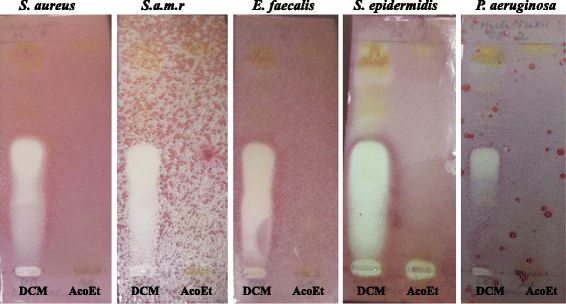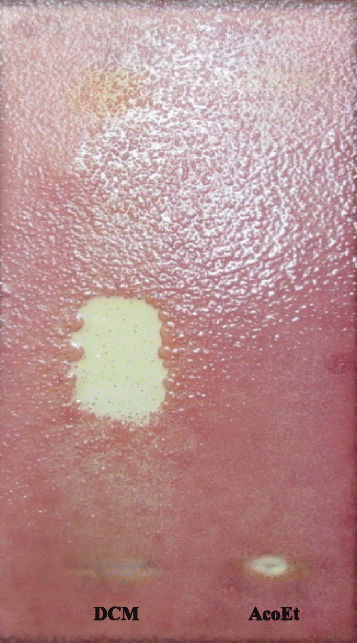Triterpenoids from Acacia ataxacantha DC: antimicrobial and antioxidant activities
- PMID: 27520306
- PMCID: PMC4983094
- DOI: 10.1186/s12906-016-1266-y
Triterpenoids from Acacia ataxacantha DC: antimicrobial and antioxidant activities
Abstract
Background: Acacia ataxacantha is a medicinal specie used extensively in traditional medicine of Benin republic to treat infectious diseases. Our previous study showed interesting antibacterial and antifungal activities against six strains of bacteria and six strains of fungi. The aim of this study was to investigate the antimicrobial and antioxidant activities of compounds isolated from A. ataxacantha.
Methods: Chromatographic and spectroscopic methods were used to isolate and identify three compounds (1-3) from the bark of A. ataxacantha. Phytochemical investigation of A. ataxacantha (Fabaceae) led to the isolation of three triterpenoids (1-3). The structure of isolated compounds was established by differents spectroscopic methods such as UV, (1)H NMR, (13)C NMR, 2D NMR and Mass. All isolated compounds were tested for antimicrobial activity using agar disc-diffusion and microdilution methods. The radical scavenging activity of isolated compounds was assessed using 2,2-diphenyl-1-picrylhydrazyl (DPPH) method.
Results: Phytochemical investigation led to the isolation and identification of lupeol (1), betulinic acid (2) and betulinic acid-3-trans-caffeate (3). Moderate antimicrobial activity was obtained with compound 3 against methicillin-resitant Staphylococcus aureus, Enterococcus feacalis and Pseudomonas aeruginosa with MIC value of 25 μg/ml and Staphylococcus aureus (MIC of 50 μg/ml). Compounds 3 was more active against Staphylococcus epidermidis and Candida albicans with a MIC value of 12.5 μg/ml in boths cases. Compounds 3 had also interesting antioxidant activity with an IC50 of 3.57 μg/ml compared to quercetin (1.04 μg/ml).
Conclusion: The overall results of this study provide evidence that the compound 3, isolated from A. ataxacantha, exhibit antimicrobial activity against Gram-positive and Gram-negative bacteria and yeast, especially against C. albicans.
Keywords: Acacia ataxacantha; Antibacterial; Antifungal; Antioxidant; Betulinic acid-3-trans-caffeate; Triterpene.
Figures



Similar articles
-
Antimicrobial and antioxidant activity and chemical characterisation of Erythrina stricta Roxb. (Fabaceae).J Ethnopharmacol. 2016 Jun 5;185:171-81. doi: 10.1016/j.jep.2016.03.011. Epub 2016 Mar 8. J Ethnopharmacol. 2016. PMID: 26969405
-
Acthaside: a new chromone derivative from Acacia ataxacantha and its biological activities.BMC Complement Altern Med. 2016 Dec 7;16(1):506. doi: 10.1186/s12906-016-1489-y. BMC Complement Altern Med. 2016. PMID: 27923358 Free PMC article.
-
Antimicrobial and antioxidant activities of triterpenoid and phenolic derivatives from two Cameroonian Melastomataceae plants: Dissotis senegambiensis and Amphiblemma monticola.BMC Complement Altern Med. 2018 May 16;18(1):159. doi: 10.1186/s12906-018-2229-2. BMC Complement Altern Med. 2018. PMID: 29769064 Free PMC article.
-
Novel targets of pentacyclic triterpenoids in Staphylococcus aureus: A systematic review.Phytomedicine. 2020 Jul 15;73:152933. doi: 10.1016/j.phymed.2019.152933. Epub 2019 Apr 23. Phytomedicine. 2020. PMID: 31103429
-
Bioactive Phytochemicals of Acacia saligna.Molecules. 2023 May 28;28(11):4396. doi: 10.3390/molecules28114396. Molecules. 2023. PMID: 37298872 Free PMC article. Review.
Cited by
-
Rubiarbonone C inhibits platelet-derived growth factor-induced proliferation and migration of vascular smooth muscle cells through the focal adhesion kinase, MAPK and STAT3 Tyr705 signalling pathways.Br J Pharmacol. 2017 Nov;174(22):4140-4154. doi: 10.1111/bph.13986. Epub 2017 Sep 22. Br J Pharmacol. 2017. PMID: 28832962 Free PMC article.
-
Proteome and transcriptome profile analysis reveals regulatory and stress-responsive networks in the russet fruit skin of sand pear.Hortic Res. 2020 Feb 1;7:16. doi: 10.1038/s41438-020-0242-3. eCollection 2020. Hortic Res. 2020. PMID: 32025319 Free PMC article.
-
Application of Amino Acids in the Structural Modification of Natural Products: A Review.Front Chem. 2021 Apr 29;9:650569. doi: 10.3389/fchem.2021.650569. eCollection 2021. Front Chem. 2021. PMID: 33996749 Free PMC article. Review.
-
GC-MS, Antibacterial and In silico Studies of Sudanese Acacia polyacantha Stem Bark Alcoholic Extract.J Exp Pharmacol. 2024 Oct 10;16:365-376. doi: 10.2147/JEP.S480839. eCollection 2024. J Exp Pharmacol. 2024. PMID: 39403318 Free PMC article.
-
Bioactive Compounds, Pharmacological Actions, and Pharmacokinetics of Genus Acacia.Molecules. 2022 Oct 28;27(21):7340. doi: 10.3390/molecules27217340. Molecules. 2022. PMID: 36364163 Free PMC article. Review.
References
-
- Lalitha P, Sripathi SK, Jayanthi P. Acute toxicity study of extracts of Eichhornia Crassipes (Mart.) Solms. Asian J Pharm Clin Res. 2012;5(4):59–61.
-
- Adjanohoun I, Ahyi M, Aké A, Akouegninou A, Dalmeida J, Akpovo F, Bouke FK, et al. Contribution aux études ethnobotaniques et floristiques en République Populaire du Bénin. Paris: ACCA; 1989. p. 852.
-
- MacDonald I, Joseph OE, Harriet ME. Documentation of medicinal plants sold in markets in Abeokuta, Nigeria. Trop J Pharm Res. 2010;9(2):110–118.
MeSH terms
Substances
LinkOut - more resources
Full Text Sources
Other Literature Sources
Medical

